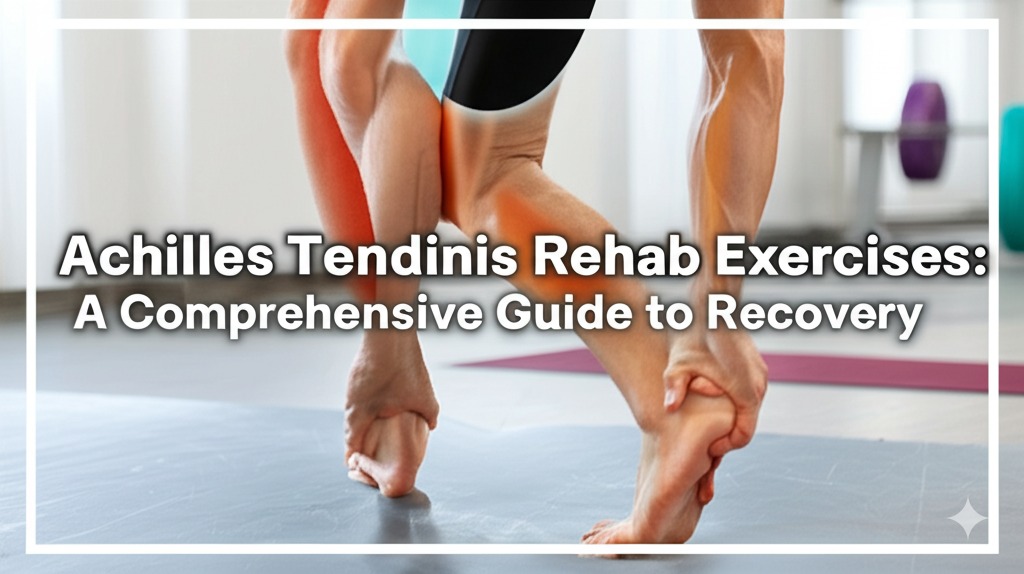Achilles tendonitis is a common injury that can cause pain and discomfort in the lower leg, particularly in athletes and those who engage in regular physical activity. This condition occurs when the Achilles tendon, the large tendon at the back of the ankle, becomes inflamed due to overuse, improper footwear, or biomechanical imbalances. If left untreated, Achilles tendonitis can lead to chronic issues and hinder daily activities.
The good news is that with the right rehabilitation exercises, you can not only reduce pain but also strengthen the tendon and prevent future injuries. In this article, we’ll explore effective Achilles tendonitis rehab exercises, tips for proper rehabilitation, and how to get back to your normal routine pain-free.
What is Achilles Tendonitis?
Achilles tendonitis refers to the inflammation of the Achilles tendon, which connects the calf muscles to the heel bone. This condition often results from repetitive stress or strain on the tendon, which leads to micro-tears in the tissue. The pain usually begins gradually and may worsen over time if left untreated.
Symptoms of Achilles tendonitis include:
- Pain along the tendon, especially after physical activity
- Swelling and tenderness in the back of the ankle
- Stiffness in the Achilles tendon, particularly in the morning
- Limited mobility in the ankle joint
If you suspect you have Achilles tendonitis, it’s important to seek medical advice to ensure an accurate diagnosis and appropriate treatment plan.
Key Exercises for Achilles Tendonitis Rehab
The road to recovery for Achilles tendonitis involves a combination of rest, strengthening, and stretching exercises. Rehabilitation exercises help to promote healing, increase flexibility, and strengthen the tendon to prevent future injuries. Here are some of the most effective rehab exercises for Achilles tendonitis:
1. Eccentric Heel Drops
Eccentric heel drops are one of the most effective exercises for Achilles tendonitis. This exercise targets the calf muscles and Achilles tendon, helping to improve tendon strength and flexibility.
How to do it:
- Stand on the edge of a step with your heels hanging off the back.
- Slowly lower your heels below the step, feeling a stretch in your Achilles tendon.
- Push back up with your good leg and then lower the affected leg slowly.
- Perform 3 sets of 10-15 repetitions, twice a day.
2. Calf Raises
Calf raises strengthen the calf muscles and the Achilles tendon, providing better support and reducing strain on the tendon.
How to do it:
- Stand with your feet shoulder-width apart.
- Slowly rise onto your toes, lifting your heels as high as possible.
- Lower back down slowly, ensuring control throughout the movement.
- Perform 3 sets of 10-15 repetitions.
For added difficulty, you can perform calf raises while standing on one leg.
3. Toe-to-Wall Stretch
The toe-to-wall stretch is a simple yet effective stretch to increase the flexibility of the Achilles tendon and the calf muscles.
How to do it:
- Stand facing a wall with your toes about 6 inches from the wall.
- Place your hands on the wall for support.
- Bend your front knee while keeping your back leg straight and your heel on the floor.
- Hold the stretch for 30 seconds and repeat 3 times on each side.
4. Seated Towel Stretch
This stretch targets the Achilles tendon and calf muscles while also promoting relaxation and flexibility.
How to do it:
- Sit on the floor with your legs extended in front of you.
- Place a towel around the ball of your affected foot.
- Gently pull the towel toward you, keeping your knee straight.
- Hold the stretch for 30 seconds and repeat 3 times.
5. Ankle Circles
Ankle circles help improve mobility and circulation around the ankle joint, aiding in the healing process and reducing stiffness.
How to do it:
- Sit or lie down with your leg extended.
- Rotate your ankle in small circles, first clockwise and then counterclockwise.
- Perform 10-15 circles in each direction, 2-3 times a day.
Tips for Effective Achilles Tendonitis Rehab
While performing exercises is crucial for rehabilitation, several other factors can aid in your recovery. Here are some tips for effective rehab:
Rest and Ice
- Rest is key to preventing further damage. Avoid activities that aggravate the pain, such as running or jumping.
- Ice the affected area for 15-20 minutes after performing exercises to reduce swelling and inflammation.
Proper Footwear
- Wear supportive shoes that provide adequate cushioning for your feet.
- Consider using orthotic insoles to correct any biomechanical issues and improve alignment.
Gradual Progression
- Start with low-impact exercises and gradually progress to more challenging ones as your strength improves.
- Avoid rushing your recovery—allow your body time to heal and adjust.
Consult a Professional
If pain persists despite performing rehab exercises, consult a physical therapist or healthcare provider. They can tailor a rehabilitation plan specific to your needs and monitor your progress.
Conclusion: Take Action and Start Your Rehab Journey
Achilles tendonitis can be a frustrating condition, but with the right rehabilitation exercises and proper care, you can recover and get back to your normal activities. Remember, consistency is key to strengthening the Achilles tendon and preventing future injuries.
Start incorporating these Achilles tendonitis rehab exercises into your daily routine, and be patient with the process. If needed, consult with a healthcare professional to ensure you’re on the right track. With time and effort, you can heal your Achilles tendon and return to pain-free movement.

Kallie Snyder is an author at Stonegate Health Rehab, providing valuable insights, recovery guidance, and rehab resources to help individuals achieve better health and well-being.
